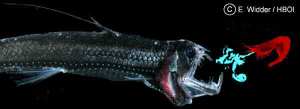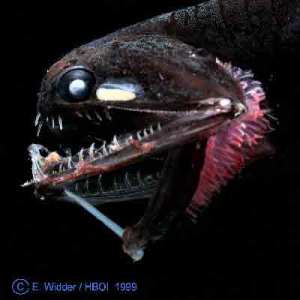Bioluminescence means light (as in ‘illuminate‘) from life (prefix ‘bio‘).
It is produced by a chemical reaction in many marine or terrestrial organisms. The reaction begins with a chemical called luciferase that catalyzes another chemical, luciferin, to then make oxyluciferin and light.
If you see bioluminescence from a boat it is most often tiny dinoflagellates near the surface of the water that begin this chemical reaction once they’re excited. A boat or a passing porpoise can trigger this excitement. On land we are familiar with bioluminescence in fireflies and a glowing fungus, called foxfire.
But, did you know bioluminescence is responsible for illuminating the majority of our habitable world? That’s right, the deep sea is the largest area of habitable space on our planet. A large number of species that utilize this adaptation live in that environment. Here are some images of the inhabitants of the deep sea that use bioluminescence:
 Deep sea shrimp, Acanthephyra purpurea
Deep sea shrimp, Acanthephyra purpurea
 Deep sea fish, Photostomias guernei
Deep sea fish, Photostomias guernei
 Blackdevil angler fish, Melanocetus johnsonii
Blackdevil angler fish, Melanocetus johnsonii
All images (c) NOAA.







What people are saying …